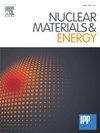Wall conditions on HL-2A and HL-3 tokamaks
IF 2.3
2区 物理与天体物理
Q1 NUCLEAR SCIENCE & TECHNOLOGY
引用次数: 0
Abstract
This paper presents the wall conditioning of HL-2A and HL-3 tokamaks. It details the enhancement of plasma performance achieved through siliconization processes on the HL-2A tokamak, encompassing both offline and in-situ methodologies. A study on the impact of offline siliconization on impurity concentration within HL-2A is presented, and real-time siliconization results demonstrate that it has no effect on plasma discharge. The findings indicate that in-situ siliconization is equally effective as the offline process with regard to plasma performance. With appropriate 13.56 MHz radio frequency (RF) power and pressure, a uniform glow discharge was achieved under 0.1 T in HL-2A. The effectiveness of impurity removal on HL-3 at different baking temperatures has been investigated. Measurements of glow discharge plasma density and temperature reveal that the parameters farthest from the electrode are 6 eV and ∼ 8 × 1012 m−3. Based on the breakdown tests, it was determined that the minimum breakdown voltage is approximate 430 V, and the lowest breakdown pressure is around 2.1 × 10-2 Pa when using 2.1 MHz RF power. Furthermore, experiments were conducted to investigate the efficiency of radio frequency assisted glow discharge cleaning for impurity removal. The study also evaluated the effectiveness of various methods for removing impurities. Additionally, siliconization on HL-3 was implemented successfully with determination of all key control parameters.
求助全文
约1分钟内获得全文
求助全文
来源期刊

Nuclear Materials and Energy
Materials Science-Materials Science (miscellaneous)
CiteScore
3.70
自引率
15.40%
发文量
175
审稿时长
20 weeks
期刊介绍:
The open-access journal Nuclear Materials and Energy is devoted to the growing field of research for material application in the production of nuclear energy. Nuclear Materials and Energy publishes original research articles of up to 6 pages in length.
 求助内容:
求助内容: 应助结果提醒方式:
应助结果提醒方式:


